# EDDF - Tower
Frankfurt Tower can be split into 4 stations as shown in the table and image below.
| **Station** | **Station ID** | **Login** | **Frequency** | **Remark** |
| **Center Tower** | DFTC | EDDF\_C\_TWR | 118.780 | **primary station** |
| **West Tower** | DFTW | EDDF\_W\_TWR | 124.855 | **secondary station** |
| **North Tower** | DFTN | EDDF\_N\_TWR | 136.500 | will be taken over by DFTW if not staffed |
| **South Tower** | DFTS | EDDF\_S\_TWR | 119.905 | will be taken over by DFTC if not staffed |
| **Ground** | DFG | EDDF\_GND | 121.805 | will be taken over by DFTS if not staffed |
Ground can also be taken over by West Tower after coordination. However, it cannot be taken over by any Apron station.
If multiple Tower stations are staffed, the responsibility for VFR traffic within the control zone can be coordinated for every single VFR flight or in general. Without coordination, South Tower is responsible for all VFR traffic (inbound VFR traffic from the North will initially call North Tower).
### Runway Usage
Frankfurt Tower is responsible for the direction of operations. 25 operation is preferred up to a tailwind component of 5 kts. Runway 18 is always used up to a tailwind component of 15 knots.
If the [tailwind component](https://sim.tools/ "sim.tools") of runway 18 is greater than 10 knots, this should be broadcasted via ATIS. Then pilots need to report if unable to accept runway 18 on initial call. It might be more efficient to close runway 18 depending on the amount of pilots that report being unable due to the required separation (see separation below).
**Approaches:** By default, the ILS Approach is used for all arrivals, except coordinated otherwise. For runway 25R/07L ILS Y is preferred without tailwind and during CAT I operations.
Inbounds for the GAT and the south apron should be instructed to vacate runway 25L/07R to the south.
### Separation and transfer of communication
#### Departing Traffic
All departures must be separated by at least **3 NM or wake turbulence separation**, whichever is greater. Tower has to ensure initial separation between departures and between departures and missed approaches.
**Departures with the same SID** need to be separated by at least 5 NM at transfer of communication.
**Rule of Thumb for aircraft with same performance:**
A separation of 3 NM can be achieved when the succeeding traffic receives its takeoff clearance as soon as the preceeding traffic is overflying the end of the departure runway. For a separation of 5 NM the proceeding traffic needs to be 2 NM away from the end of the departure runway.
**Same SID, different runways:** Especially between southern departures out of runways 07/25 and 18, Tower has to pay special attention to initial separation.
All departing aircraft out of Frankfurt must be instructed to contact the appropriate Langen Radar frequency after departure. This instruction shall be given when the aircraft is airborne and free of conflict with other departures and / or missed approaches. The transfer should be initiated early enough to avoid the flight leveling off (at +/- 1000 ft AMSL).
As the approach / departure controller shall always cross-couple both real-life departure frequencies, the departure frequency will always be 120.155 for departures towards MARUN, TOBAK, OBOKA and 136.130 for departures towards SULUS, KOMIB, CINDY, ANEKI, SOBRA and ULKIG - regardless of the departure runway / SID.
#### Arriving Traffic
For inbounds, Frankfurt Arrival is responsible for separation until transfer of communication. Frankfurt Tower is responsible for maintaining separation of arriving traffic from transfer of communication until touchdown, if necessary by use of adequate means (e.g. speed control), and during the initial part of a missed approach.
The minimum separation between two aircraft approaching the same runway is **3 NM or wake turbulence separation**, whichever is higher.
However, under certrain circumstances, the radar separation can be reduced to **2.5 NM** according to NfL I-55/11:
- Both aircraft are within a 10 NM final
- Wake turbulence separation is not applicable
- The exit taxiways of the runway can be observed from the control tower visually or by means of surface movement radar (always applicable at VATSIM)
- The runway is dry
The reduced radar separation minimum may also be applied between alternating approaches to the parallel runways (see below). In these cases, neither the line of sight of the exit taxiways nor the runway conditions need to be considered as a precondition.
**Modes of Operation:** Langen Radar has to coordinate with tower whether parallel independent, dependent or alternating (former staggered) mode will be used. The minimum separation between an aircraft on final runway 25L/07R and another aircraft on final runway 25R/07L is measured diagonal head to head.
| **Mode**
| **Minimum separation 25L/07R - 25R/07L**
|
| alternating
| 2.5 NM
|
| dependent
| 1.5 NM
|
| parallel independent
| independent
|
The default mode with only one arrival / feeder controller is **dependent**. Only when two feeders are in use, **independent** operations are possible. Aircraft performing non-precision approaches (RNP, swingovers) are not allowed for dependent and independent operations.
For different seperation examples check the images below.
Separation Examples
| [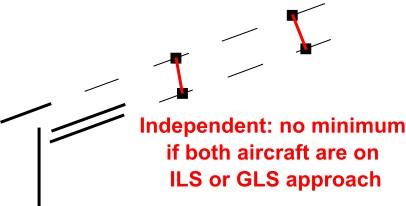](https://knowledgebase.vatsim-germany.org/uploads/images/gallery/2024-10/eddf-seperation-independant.jpg)
| [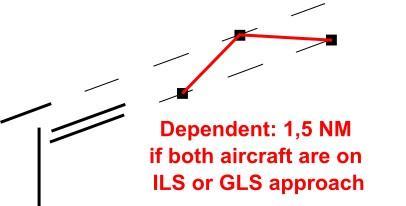](https://knowledgebase.vatsim-germany.org/uploads/images/gallery/2025-04/eddf-seperation-dependant.jpg)
|
| [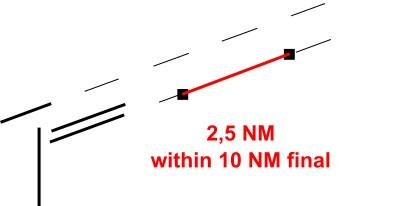](https://knowledgebase.vatsim-germany.org/uploads/images/gallery/2024-10/eddf-seperation-same-rwy.jpg) | [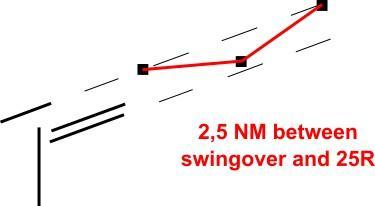](https://knowledgebase.vatsim-germany.org/uploads/images/gallery/2025-04/eddf-separation-swing.jpg) |
| **Runway** | **preceding CAT 1/CAT 2**
**succeeding CAT 1**
| **preceding CAT 1/CAT 2**
**succeeding CAT 2**
| **preceding CAT 3**
**succeeding CAT 1/CAT 2/CAT 3**
|
| **07L/25R** | 600m | 1500m | 2400m |
| **07C/25C** | 600m | 1500m | 2400m |
| **07R/25L** | 600m | 1500m | 2400m |
| **18** | N/A | N/A | 2400m |
### Runway Dependencies
The parallel runway systems 25L/25C and 07C/07R cannot be used for (in)dependent parallel approaches or independent parallel departuers. Instead, radar separation or wake turbulence separation must be applied for departures and arrivals.
However, during approaches on the southern or the center runway, the other runway may be used for departures simultaneously (taboo zones for runway 25 have to be considered though, see below).
#### 25 Operations
**M/H-Departure and departures to the south (e.g. CINDY#F):** Takeoff clearances for runway 25C/25L can be issued when the following conditions are met:
- **Inbound Traffic:** For departures out of runway 25C, the takeoff roll may only start when there is no inbound for runway 25L between 4 NM final and the threshold. For inbounds and outbounds on the same runway, only runway separation has to be applied.
- 25R missed approaches are completely independent to 25C departures with initial turn to the south
- **Outbound Traffic:** Takeoff clearance may be given once the departure on runway 18 has started its takeoff roll
**F/G-Departure to the north:** Takeoff clearances for runway 25C/25L can be issued when the following conditions are met.
- The takeoff roll may only start when there is no inbound for runway 25R between 4 and 0,5 NM final
- (Independent to arrivals on runway 25L)
- (25C: Independent to departures from runway 18)
- Departures out of runway 25L need a release by DFTW. The release can be given once the departure from runway 18 is rolling
- During LVO both tabu zones for 25L and 25R need to be clear of traffic when starting the takeoff roll. Since this is almost impossible during high inbound traffic, all departures should receive the M/H SIDs during LVO so that only one taboo zone has to be considered.
**18 Departures:** Outbounds from runway 25C/25L with initial turn to the south need to reach 2000ft AMSL before the takeoff clearance can be issued. Outbounds from runway 25C directly to the north are completely independent to all 18 departures.
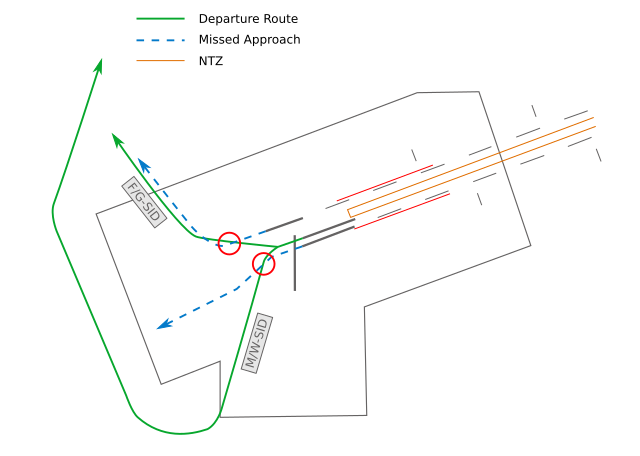*dependencies during 25 operations*
**Missed Approaches:** Missed approaches from runway 25C and 25L are dependent to runway 18 departures. The takeoff clearance on runway 18 can be given, as soon as separation is ensured. Exception: Departures from intersection S are independent to missed approaches. However, a traffic information could increase the situational awareness of the pilot.
**Staffing with multiple tower:** If more than one Tower position is staffed, DFTW is responsible for the coordination between departures runway 18 and 25C/25L. DFTC/DFTS always needs a release by DFTW for all departures with initial turn to the south (M / W / H / K / N / F-SIDs to the south), if not coordinated otherwise. E.g. the phrases "Released" / "DLH123 released" / "MARUN released" may be used.
#### 07 Operations
**Outbounds 07:** All outbounds out of runway 07C are independent to all arrivals on runway 07R and departures on runway 18.
In case of a go around on runway 07R, Tower has to ensure separation. In case of a southbound departure from RWY 07C, the missed approach should be turned to the south above the MVA and the departure should stay on runway track.
Missed approaches on RWY 07L and OBOKA/MARUN#E departures are **not** separated procedural. In case of go around on runway 07L, Tower has to ensure separation with departures out of runway 07C.
**18 departures:** Departing aircraft on runway 18 from N / N-South / L have to start their takeoff roll before any aircraft on final runway 07R is between 4 NM final and runway 18. Also, traffic departing from these intersections need to be separated by time-based wake turbulence behind arrivals on runway 07R (see table below).
For departures out of **intersection M** it must only be ensured that the inbound will not overfly the departing traffic on runway 18, so the 4 NM restriction does not need to be taken into account as well as wake turbulence separation. Departing traffic out of full length can taxi down the runway to intersection M (not via taxiway Y) to improve the departure sequence.
> DLH123, lineup runway 18, on the runway taxi down to intersection M.
Outbounds via **intersection S** are completely independent to arrivals for runways 07C and 07R.
##### Time-based wake turbulence separation 18 Outbound vs. 07R Inbound
| **Preceding** | **Succeeding** | **Separation** |
| Medium | Light | 2 min |
| Heavy
| Light | 2 min |
| Medium | 2 min |
| Super
| Light | 3 min |
| Medium | 3 min |
| Heavy | 2 min |
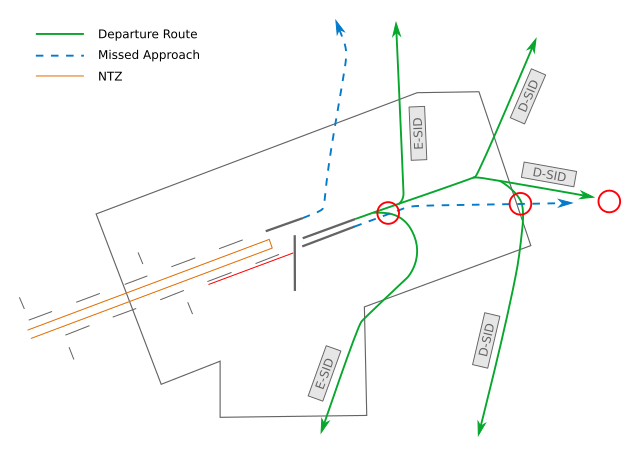*dependencies during 07 operations*
#### Spacing on final
Due to the taboo zones, it might be necessary to coordinate a target spacing on final to get departures out, especially during an inbound rush. This can be done either individually for each departure (good preplanning is necessary - when the final is full, the next gap might take around 6 minutes) or by using a general spacing on final.
Recommended spacing values are:
- **07R arrivals:** 5 NM (minimum 4 NM at touchdown)
- **07L arrivals:** Radar Separation
- **25L arrivals:** 6 NM (minimum 5 NM at touchdown)
- **25R arrivals:** 5 NM (minimum 4 NM at touchdown)
### VFR Traffic
D-CTR of Frankfurt reaches up to 2500ft AMSL. For details see VFR charts.
**Runway used:** VFR Traffic should use runway 25L/07R for arrival, outbounds can depart from any runway (except 25R/07L) depending on the traffic situation and the intentions of the VFR traffic. VFR departures out of runway 25L/25C can be instructed not to overfly runway 18. Nevertheless, it is necessary to wait with an 18-takeoff clearance until the VFR departure turns away from runway 18. Low approaches / Touch and go's can only be performed on the center or southern runway, whatever facilitates the traffic flow. The northern runway is not allowed for VFR approaches due to noise abatement. However, the downwind of this runway can of course be used.
There are VFR holdings in the control zone north and south of the airport. Traffic in these holdings shall be instructed to stay clear of runway 18 or final runway 25R.
**VFR Squawk:** All VFR traffic inside the controlzone of Frankfurt will get the transpondercode 4447. Police (POL - 0036) and Christoph rescue helicopter (CHX - 4444) will remain their squawk.
**Helicopter Operation:** All helicopters always have to land or depart at an active runway at Frankfurt airport. Thereafter they need to air-taxi to their destination at the airport (usually a stand at the GAT or next to the accident side).
**Important Landmarks for VFR Flights**
- River Main
- Downtown Frankfurt (Northeast of the CTR)
- BAB 3 (west to east through the CTR)
- BAB 5 (north to south through the CTR)
- BAB 60 (Splitting of BAB 67 to the west)
- BAB 67 (north to the southwest of RWY 18)
- Frankfurt Uniklinik (Northeast of the CTR)
[VFR Charts - Openflightmaps](https://www.openflightmaps.org/ed-germany/)
**Wiesbaden corner:** To facilitate traffic circuit operations at Wiesbaden airbase (ETOU), the Northwestern corner of the Frankfurt CTR can be delegated to Wiesbaden Tower up to 1500ft. In addition, controllers shall be aware that in addition to the traffic circuits, Wiesbaden VFR routes Echo and Apache also cross the Frankfurt CTR along Autobahn 66.
Wiesbaden corner
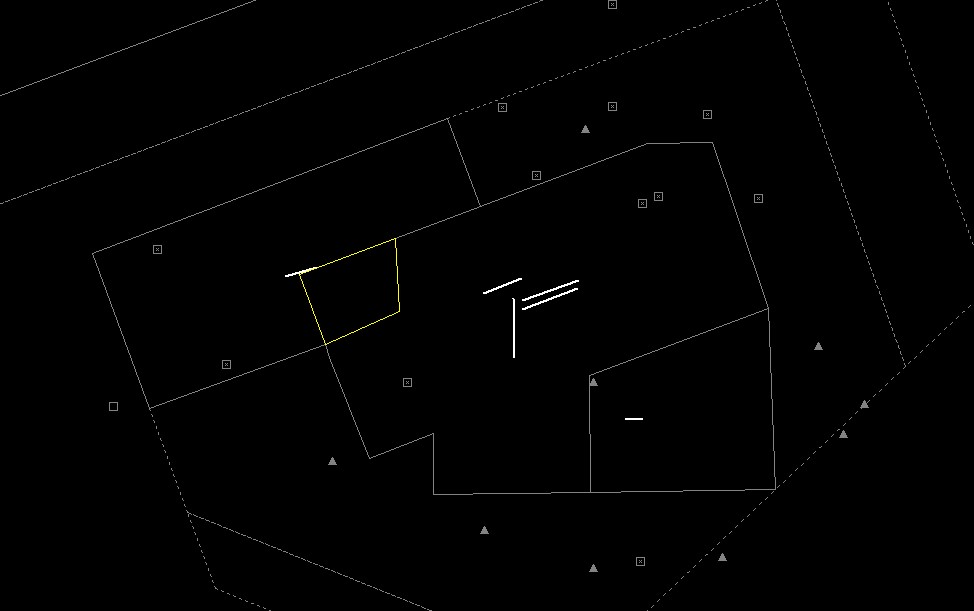
The Wiesbaden corner will automatically be displayed when Wiesbaden Tower is staffed, but can also be manually displayed via the TopSky maps, e.g. if there is circuit traffic at Wiesbaden while DFAN covers the airport topdown.
Tower will get Outbounds for runway 07C/25C short of the intersections. The intersection to use can be decided by Tower depending on the best departure sequence. Therefore only L1, L3, L4, L5, L6 and L9 can be used during 25 operations and L14, L16, L17, L19, L20, L21 for 07 operations. Tower needs to instruct the pilot to join the intersection.
Usage of Intersections
Only intersections with a published TORA (see charts) may be used for departures, even if the pilot reports that he would be able for a different intersection. As an exception, helicopters may depart from every part of the runway up to the runway end.
Generally, an intersection may only be assigned to a departing aircraft when the pilot either reports by himself that he is able for that intersection or agrees to it after a controller’s request - regardless of the aircraft type.
In theory, every pilot has to report the earliest possible takeoff intersection to the tower controller according to the AIP EDDF. This is often not done in practice though, therefore the tower controller still needs to ask if the pilot is able to use an intersection. Exemptions of this rule are intersections L and M of runway 18 during 07 operations. The ATIS states that these are to be expected for every aircraft and pilots have to report if they are unable for M.
Also, it is common practice to assign the following intersections without prior agreement since they only differ by a few meters from full runway length: L3 (25C), L20 (07C), N-South / L / W3 (18 - only applies for Mediums, Heavies have to be asked).
To protect the center runway, all traffic holding short **can** be instructed to stop at the CAT II/III holding point (real procedure)! As many pilots are confused by this instruction, a "normal" hold short of the runway can be used instead.
> **Frankfurt Tower**: DLH123A, taxi via M and M8, hold at CAT II holding point runway 25C.
> or
> **Frankfurt Tower**: DLH123A, taxi via M and M8, hold short of runway 25C.
During 07 Operations inbounds landed on runway 07L with parking position west of N11 should be transferred directly to West Apron.


Inbound traffic entering the Apron without crossing the runway will be instructed according to the table below. Frankfurt Apron is always responsible for all GAT and movements at the southern apron!
| **Entry** | **Stand** | **Hold short of** |
| P | all except those via P1 | N11 |
| P1 | F231 - F238 and V266 - V270 | W |
| S4 - S23 | South Parking (S, V3xx, J, K, G) | S4 - S23, according to the stand |
Do not label hold shorts that are defined by the SOP!
### Visual Swingovers
Inbounds for runway 25L have the possibility to do a visual swingover (visual approach) to runway 25C when reaching the 7 NM final (2500ft MSL). Therefore the pilot has to have the runway in sight. During 07 operations a swingover is only available for safety reasons or to avoid a missed approach.
**Dependencies:** Visual swingovers must be separated by at least 2.5 NM to approaches on runway 25R/07L. They do not have to be coordinated with Langen Radar as long as separation to other aircraft is obviously great enough. If the 2.5 NM cannot be maintained, the procedure can still be applied if the **succeeding** aircraft confirms the parallel traffic in sight and maintaining visual separation.
**Missed Approach:** With the clearance for the visual approach the pilot has to be given a new instruction how to continue in case of a missed approach. Therefore runway track and a climb to 5000ft shall be used.
> **Frankfurt Tower**: DLH123, advise able for visual approach runway 25C and parallel A320 2 o'clock in sight?
>
> **Pilot**: Able and in sight, DLH123.
>
> **Frankfurt Tower**: DLH123, maintain own separation, cleared visual approach runway 25C, (do not overshoot to the north). In case of missed approach climb straight ahead 5000ft (and contact Frankfurt Tower 118.780).
A swingover can have several benefits. The taboo zone can be avoided (see below) or safety reasons e.g. to avoid missed approaches. Pilots are often happy about reduced taxi times on ground.
**Swing to depart**: A swingover can also be used to improve the outbound flow for runway 25C with M/W departures, as there is no 4 NM no-fly zone that need to be taken into account. A takeoff clearance on runway 25C can also be issued if the inbound is closer than 4 NM, which would not be possible if this traffic was approaching runway 25L.
The inbound will be handed over to the according apron, with a hold short of L, as soon as possible.
> **Frankfurt Tower**: DLH123, vacate to the right, hold short of L and contact Frankfurt Apron 121.855.
### Low Visibility Operations
LVO become effective once the **ceiling / vertical visiblilty is below 200ft or the vertical visibility cannot be detected or any RVR in the METAR is equal or below 600m.**
During LVO, the following procedures shall be applied:
- LVO shall be **announced** in the **ATIS** (Code "&lvp")
- Only the **Z ILS** for the northwestern RWY may be used
- All traffic shall be told to **hold at the CAT III holding points**
- The **RVR value for the corresponding runway** shall be given with the **landing clearance** and in the case of guided take-off (RVR ≤ 125m) with the take-off clearance
- **25 Departures** should only depart from RWY 25C via **M/W SIDs** (reason: F/G Departures and a missed approach on runway 25L would mean a loss of separation during bad weather, but M/W SIDs are independent to published missed approaches from runway 25R)
- **Runway crossings are not allowed**
- During RWY 25, landing traffic that would cross via M8 shall taxi via T and traffic that would cross via M30 shall taxi via Y
- During RWY 07, all landing traffic shall taxi via T
- Optional procedures for advanced controllers: Consideration of sensitive and critical areas of the ILS
- The sensitive and critical areas for every runway and aircraft category can be displayed in Euroscope via Functions -> Maps -> LVP
- [](https://knowledgebase.vatsim-germany.org/uploads/images/gallery/2024-11/screenshot-20.png) Yellow areas show the sensitive areas
- [](https://knowledgebase.vatsim-germany.org/uploads/images/gallery/2024-11/screenshot-22.png) Orange areas show the sensitive areas for non-orthogonal and non-parallel traffic
- [](https://knowledgebase.vatsim-germany.org/uploads/images/gallery/2024-11/screenshot-21.png) Red areas show the critical areas
- The wake turbulence category always refers to the preceeding aircraft on the runway, not the suceeding on final
- For Light and Medium aircraft, there are no restrictions except that they must be clear of the CAT III holding point before the next inbound is over the runway threshold
- For Heavy / A388 aircraft:
- Sensitive areas must be clear as soon as the next inbound is within 2 NM final
- As a rule, sensitive areas are always clear when the aircraft has passed the CAT III holding point
- Critical areas must be clear as soon as the next inbound is within 4 NM final
- When applying these advanced procedures, the following spacing should be the coordinated with APP for arriving flights:
- 5 NM behind Light / Medium aircraft
- 7 NM behind Heavy / A388 aircraft